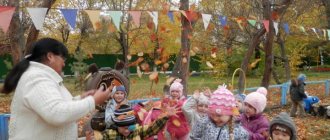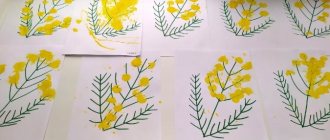Preview:
Calendar and thematic planning of GCD in the middle group.
Artistic and aesthetic development. Drawing.
Literature: Komarova T. S. “Visual activities in kindergarten.” Middle group. 2014 Complies with Federal State Educational Standard.
Goals (program content)
1-2 weeks of September “Kindergarten, Knowledge Day”
1. Draw a picture about summer
Teach children to reflect their impressions in accessible ways. Strengthen the techniques of painting with a brush, the ability to hold a brush correctly, rinse it in water, and dry it on a cloth. Encourage drawing of different objects in accordance with the content of the drawing.
Komarova T. S. s. 23.
2. Colored balls (round and oval)
Continue to introduce techniques for depicting oval and round objects. Develop the ability to compare these forms, highlight their differences, and convey the distinctive features of the forms in the drawing; consolidate shading skills by lightly touching the pencil to the paper; develop a desire to achieve good results
Komarova T. S. s. thirty.
3, 4 weeks “Autumn”
3. Beautiful flowers
Develop observation skills and the ability to choose an object to depict. Learn to depict parts of a plant in a drawing. Strengthen the ability to paint with a brush and paints, hold the brush correctly.
Komarova T. S. s. 27.
4. Apples are ripe on the apple tree
Develop the ability to draw a tree, conveying its characteristic features: a trunk, long and short branches diverging from it; convey the image of a fruit tree in the drawing; reinforce drawing techniques with wax crayons.
Komarova T. S. s. 25.
1st, 2nd weeks of October “Autumn”
1. Testicles are simple and golden
To consolidate knowledge of the oval shape, the concepts of “blunt” and “sharp”. Continue teaching the technique of drawing an oval shape. Practice the ability to carefully paint over drawings. Lead to figurative expression of content. Develop imagination.
Komarova T. S. s. 36.
2. Golden autumn.
Develop the ability to depict autumn; practice the ability to draw a tree, trunk, thin branches, autumn foliage. Strengthen technical skills in painting with paints (dip the brush with all its bristles into a jar of paint, remove an extra drop on the edge of the jar, rinse the brush well in water before adding another paint, blot it on a soft cloth or paper napkin, etc.). Lead to figurative transmission of phenomena. Foster independence and creativity. Induce a feeling of joy from bright, beautiful drawings.
Drawing in the middle group October according to Komarova. Long-term planning in fine arts (middle group)
Long-term planning for educational activities in drawing middle group 2015 – 2016 academic year
Equipment:
September 1. Drawing according to the plan “Draw a picture about summer”
Page 27 T.S. Komarova Teach children to display their impressions using accessible means. Gouache of different colors or wax crayons, album sheets, a brush, a jar of water, a napkin.
2. "Beautiful flowers"
Page 31 T.S. Ushakova Develop observation skills, the ability to choose an object to depict. Colored pencils or wax crayons, album sheets.
3. “Apples are ripe on the apple tree”
Page 29 T.S. Komarova Continue teaching children to draw a tree, conveying its characteristic features - the trunk, long and short branches diverging from it. Colored pencils or colored wax crayons, album sheets, photographs of flowers.
4. "Gold autumn"
Page 35 T.S. Komarova Teach children to depict autumn, autumn foliage. Landscape sheets, gouache paint, brushes, a jar of water, a napkin.
5. "Fairytale Tree"
Page 37 T.S. Ushakova Teach children to create a fairy-tale image in a drawing. Pencils, album sheets, 12 sheets of paper.
October 6.Drawing according to the plan “Autumn”
Page 42 T.S. Ushakova Teach children to independently choose the theme of the drawing and bring their plans to the end.
White paper 12 sheets, colored pencils for each child.
7. "Little Dwarf"
Page 46 T.S. Komarova Teach children to convey in a drawing the image of a little man - a forest gnome, making an image from simple things - a small head - a round, cone-shaped shirt. Gnome - toy, 12-sheet paper, gouache paints, brushes, jar of water, napkin.
Lesson 71. Drawing “Fairytale house-teremok”
Program content. Teach children to convey the image of a fairy tale in a drawing. To develop imaginative ideas, imagination, independence and creativity in depicting and decorating a fairy-tale house. Improve decoration techniques.
Methodology of conducting the lesson.
Recall with your children a fairy tale that tells about a tower. Clarify its shape, activating the children: a rectangular wall, small windows, a triangular roof. Emphasize that the tower is beautiful: all the animals liked it so much that they wanted to live in it. Invite children to draw and decorate a fairytale house. Encourage the depiction of additional details that correspond to the theme of the drawing.
When most of the children have drawn the main parts of the mansion, invite them to think about how they will decorate the mansion and where they will place the decorations.
Review the finished work with the children. Admire the resulting beautiful houses and highlight the most interesting decorations.
Materials.
Colored pencils (or crayons), square sheets of paper, brushes, a jar of water, a napkin (for each child).
Connections with other activities and activities.
Reading fairy tales, looking at illustrations, houses in the immediate environment; highlighting the unusual shape of windows, special details: turrets, decorations, etc.
Lesson 72. Modeling “Bowls for Three Bears”
Program content
. Teach children to sculpt objects of the same shape, but different sizes. Practice making bowls. Practice sculpting techniques: rolling and flattening, deepening by pressing, smoothing edges with your fingers. Learn to separate lumps corresponding to the size of future objects. Learn to create objects for a dramatization game based on a fairy tale.
Methodology of conducting the lesson.
Invite the children to make bowls for three bears (put bears of different sizes on the table). Remember modeling techniques.
Materials.
3 toy bears (different sizes). Clay (plasticine), modeling board, stack (for each child).
Lesson 73. Application “Riddles”
Program content.
Strengthen children's ability to correlate flat geometric shapes with the shape of parts of objects, create an image from ready-made parts, and independently cut out small parts. Practice careful gluing. Develop creativity, imaginative perception, imaginative ideas, imagination.
Methodology of conducting the lesson.
Tell the children that each of them has a riddle in the envelope - a picture. Invite each child to think about what can come out of the prepared parts. Explain that if any small parts are missing, you can cut them out from the strips lying on the trays. For children who have difficulty composing an image, help with leading questions about the shape of the object, its components, location, etc.
Materials.
Envelopes with ready-made parts from which you can create images of objects familiar to children (a house, a carriage, a flower, a boat, a snow woman, a tumbler, etc.), strips of paper of different colors, glue, a glue brush, a napkin, an oilcloth (for each child) .
Connections with other activities and activities.
To clarify knowledge of the shape of parts of objects in didactic games with toys. Observations, conversations with children about the objects around them, the characteristic features and purpose of objects.
Lesson 74. Modeling “Lamb” (In the image of the Filimonov toy)
Program content.
Introduce children to Filimonov toys (birds, animals). Induce a positive emotional attitude towards them. Learn to highlight the distinctive features of these toys: beautiful smooth shape; bright, elegant stripes. Make you want to make such a toy.
Methodology of conducting the lesson.
Place several different Filimonov toys on the teacher’s table. Draw children's attention to what they are made of, to their bright, unusual coloring: red, yellow, green stripes on a white background. Invite the children to make a lamb and examine the shape of the toy. Let me remind you that this toy is a little similar in shape to the Dymkovo goat; highlight the differences: the neck and body are more elongated, other elements and colors are used in the painting. Ask the children how to make a lamb.
Review the finished work with the children. Invoke joy from sculpted figures.
Materials.
Clay, modeling board (for each child).
Lesson 75. Drawing “My beloved sun”
Program content.
Develop figurative ideas and imagination of children. Reinforce previously learned drawing and coloring techniques.
Methodology of conducting the lesson.
Remind children that in spring the sun shines longer and brighter and warms the earth better; the sun brings warmth and light to people. Invite the children to remember poems and songs about the sun. Offer to draw a sun - your own, unlike others. Ask what shape the sun is, what color it can be (depending on the time of day, etc. the sun can be light yellow, almost white, red, orange, pink). Listen and complement the children’s answers. Ask how you can draw sun rays. Call the child to demonstrate how to draw on the board. Encourage original images during the drawing process.
Lay out all the finished works on the table, examine them, and enjoy the beautiful bright drawings with the children. Highlight interesting solutions. Hang the drawings in the group: let it have a lot of sunlight and warmth.
Materials.
Square (20x20 cm) sheets of paper (you can take lightly tinted paper), gouache paints or colored greasy pastels, brushes, a jar of water, a napkin (for each child).
Connections with other activities and activities.
Observations on a walk, reading poems, singing songs about the sun.
Lesson 76. Application “Cut out and paste what you want”
Program content.
Teach children to conceive an image and subordinate subsequent work to the plan. Learn to cut out rectangular and round parts of objects, small parts from paper. Foster independence and creativity.
Methodology of conducting the lesson.
At the beginning of the lesson, talk with the children about what kind of picture they want to cut out from the pieces of paper that are in their envelope. If the children find it difficult, name 2-3 simple scenes including 2-3 objects (for example, there is a bench under a tree, the sun is shining; boats are floating on the river, the sun is shining; a chicken is walking on the grass, etc.).
Materials.
Colored paper and white paper the size of 1/2 landscape sheet, brushes, a jar of water, a napkin (for each child).
Connections with other activities and activities.
Arrange a small exhibition of appliqué works made by children. Remove it before class. Select simple pictures to enrich children’s impressions and look at them with the children.
Lesson 77. Drawing “Your favorite doll”
Program content.
Teach children to create an image of their favorite toy in a drawing. Strengthen the ability to convey the shape, location of parts of the human figure, their relative size. Continue learning to draw large, on the entire sheet. Practice drawing and painting. Continue learning to look at pictures and justify your choice.
Methodology of conducting the lesson.
Look at the doll with the children. To say that the doll is beautiful, pay attention to the shape and size of the parts, their location. Invite each child to draw his favorite doll (this could be a soldier doll, a sailor doll, etc.). Encourage independent choice. Remind about careful painting: the doll must be beautiful. Check that children are holding the pencil correctly. Looking at the drawings at the end of the lesson, invite some of the children to talk about the dolls they drew and explain why they drew them.
Materials.
1/2 landscape paper, colored pencils (12 colors), colored wax crayons or markers (for each child).
Connections with other activities and activities.
During the games, look at different dolls, talk with children about their favorite dolls: how the child plays with the doll, what she is wearing, etc.
Lesson 78. Modeling “Cup”
Program content.
Teach children to sculpt dishes using the techniques of rolling, pressing and leveling the edges of the mold with their fingers. Practice connecting parts by pressing and smoothing the fastening points.
Methodology of conducting the lesson.
Examine the cup with the children and determine its shape. Ask the children how to sculpt a cup, then invite one of them to show and explain the sculpting techniques at the board.
During the lesson, direct the children’s actions towards a more perfect image. If necessary, resort to individual demonstration of sculpting techniques.
Materials.
Calyxes. Clay, modeling board, stack (for each child).
Connections with other activities and activities.
Games with dishes in the play corner. Consideration of cups that are used for breakfast and lunch.
Lesson 79. Drawing “The House You Live In”
Program content.
Teach children to draw a big house, convey the rectangular shape of the walls, rows of windows. Develop the ability to complement the image based on impressions of the surrounding life. Encourage children to want to look at their drawings and express their attitude towards them.
Methodology of conducting the lesson.
Remember with your children what kind of houses they live in. Clarify their shape, proportions, location of floors, doors. Call the child to the board (optional) to demonstrate how to draw at home. For those kids who can quickly draw a house, offer them to draw something additional: grass, trees, benches, the sun, etc.
Materials.
Light gray paper, gouache in soft shades and for additions - brown, green, yellow; brushes, a jar of water, a napkin (for each child).
Connections with other activities and activities.
Observations on walks with a teacher and parents. Looking at illustrations. Construction from building material.
Lesson 80. Modeling “Dishes for dolls”
Program content.
Strengthen children's ability to sculpt dishes. Practice sculpting techniques. Foster activity, independence and accuracy in work. Continue to develop teamwork skills.
Methodology of conducting the lesson.
Start the lesson with a game situation. Show the children the Bear (Bunny, Hedgehog) and tell them on behalf of the toy that the dolls and their friends want to have a holiday (birthday), but they don’t have enough dishes. Invite the children to help with the toys by making dishes for them. Consider simple utensils for dolls and offer to fashion cups and saucers and bowls for treats. Clarify sculpting techniques. Distribute work among children. If any of the guys want to make any other pieces of utensils, provide such an opportunity. Draw children's attention to more accurately conveying the shape of the dishes and to being careful in their work. For those who quickly sculpt one object, offer them to sculpt something else.
At the end of the modeling, place all the works on the teacher’s table and, together with Mishka, carefully examine them and select the most beautiful ones. Emphasize the variety of products.
Materials.
Dinnerware set. Clay, modeling board, stack (for each child).
Connections with other activities and activities.
Modeling of individual dishes. Children's games in the play corner.


